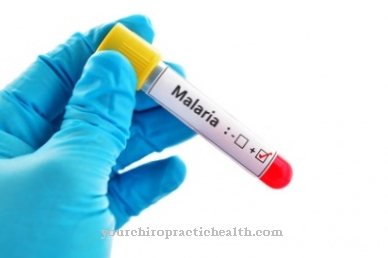The active substance Paclitaxel is used to treat different types of cancer. It has the property of inhibiting the division and reproduction of cancer cells.
What is Paclitaxel?

Paclitaxel is a cytostatic drug. It belongs to the group of taxanes and is used to treat various types of cancer. These include a. Ovarian and breast cancer. The remedy comes from the bark of the Pacific yew tree (Taxus brevifolia).
Research on paclitaxel began in the late 1960s by scientists M. C. Wani and Monroe E. Wall, who began an extensive search for new anti-cancer agents. In 1971 the two researchers succeeded in isolating the substance paclitaxel for the first time by extracting a Pacific yew tree. During this process, they discovered an anti-growth effect on cancer cells.
Paclitaxel is currently offered as a concentrate for infusion. The product has been available in Europe since the early 1990s.
Because the demand for natural Pacific yew cannot be met due to its low distribution, the medicinal substance has been partially synthesized from baccatin III in recent years. This substance is contained in the needles of the European yew tree and is obtained using the Ojima-Holton method. Alternatively, it is also possible to obtain paclitaxel biotechnologically from yew cell cultures.
Pharmacological effect
As already mentioned, paclitaxel comes from the yew tree, which is a deciduous tree and has needle-shaped leaves. With the help of the drug, an anti-cancer effect is possible. Paclitaxel interferes with the division of cancer cells and belongs to the subgroup of mitosis inhibitors.
During cell division, microtubules (bundles of threads) build up. At the decisive moment, they are able to attract duplicated chromosomes, which are part of the genetic make-up. Through this process they ensure the formation of an independent cell.
In contrast to the cytostatic agent vinblastine and the gout preparation colchicine, which have a direct inhibitory effect on the structure of microtubules, paclitaxel can prevent their breakdown. In this way, an abnormal bundle structure of the microtobules arises within the framework of the cell cycle, which in turn leads to the impairment of genetic material division. By stabilizing the microtubules, the entire internal structure of the cells is also affected.
Paclitaxel has the ability to affect all dividing cells. This increases the risk of side effects. However, the cancer cells are more severely affected because they divide particularly quickly.
Medical application & use
Paclitaxel can be used to treat various types of cancer. It is given together with the cytostatic drug cisplatin for the treatment of advanced ovarian cancer.
The remedy is also suitable if, following a surgical procedure, remnants of the tumor that are more than one centimeter in size have remained in the body. Treatment with paclitaxel is also possible when metastases (daughter tumors) occur, if substances containing platinum do not lead to an improvement.
Paclitaxel is also administered for breast cancer in which metastasis has already occurred in the neighboring lymph nodes. However, this requires pre-treatment with cyclophosphamide and anthracyclines.
Paclitaxel is also suitable for combination therapy with the monoclonal antibody trastuzumab if the patient has a special growth receptor on the cancer cells and anthracycline treatment is not suitable. Paclitaxel is only used on its own in breast cancer treatment if the anthracycline therapy is unsuccessful.
If radiation or surgery cannot be performed in non-small cell lung cancer, paclitaxel is given together with cisplatin. The use of paclitaxel is also considered suitable for Kaposi's sarcoma. This is a special type of cancer that occurs primarily in AIDS patients.
Paclitaxel is administered in the form of an intravenous infusion.
Risks & side effects
Taking paclitaxel can sometimes have bothersome side effects. The most common infections are in the upper respiratory tract. These include runny nose, sore throat, oral thrush and cold sores. In addition, urinary tract disorders, bleeding, anemia, a lack of white blood cells, inflammation of the mucous membranes, skin rashes, hot flashes, abnormal sensations in the nerves, diarrhea, nausea, vomiting, constipation, abdominal pain, muscle problems, joint pain, hair loss and edema come on the limbs.
Less common side effects include dizziness, nerve dysfunction, nervousness, flu-like symptoms, headaches, changes in taste, ringing in the ears, racing heart, fainting fits, itching, acne, calf cramps, bone pain, back pain, chest pain, depression, chills and fever. Patients must wear sun protection on their hands and feet during treatment.
There are also some contraindications to paclitaxel. The agent must not be administered if the patient is markedly hypersensitive to the drug. Other contraindications are non-treatable infections in the case of Kaposi's sarcoma, the presence of neutrophils, and severe liver disorders. In the case of cardiac dysfunction or mild liver dysfunction, the doctor must carefully weigh the risk and benefit.
There is no information available on the use of paclitaxel during pregnancy. However, it must not be administered during pregnancy because, like other cytostatics, it can damage the pregnant woman. Paclitaxel should also be avoided during breastfeeding, as it is not known whether the agent passes into breast milk.
Before using paclitaxel in ovarian cancer, it is important to always administer the preparation before the cytostatic drug cisplatin. If used the other way around, there is a risk of a stronger impairment of the bone marrow function.























.jpg)



